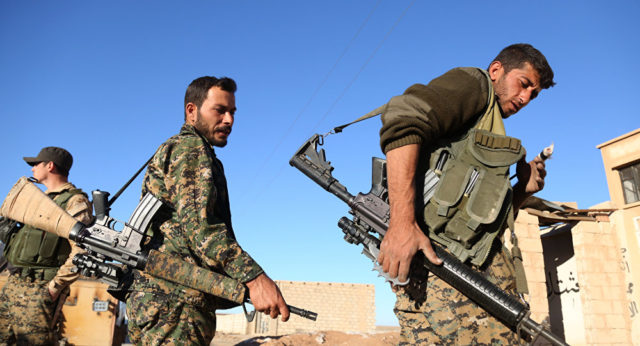The good news is various forces are attacking ISIS (the Islamic State) and its control of territory is weakening. But as it does, historical adversaries are converging on the battlefield and American troops are standing between them in ever-increasing numbers. What began as limited airstrikes has become an American ground presence. Changes begun in the previous administration continue in the current one.
This is not Vietnam. But as the numbers increase, it is worth noting that GIs are in Syria, Iraq, Yemen, Libya, Somalia and Afghanistan without the United States being at war with any of these countries or necessarily supporting any of their governments. But neither President Obama nor President Trump has talked to the American people about three essential things here: America’s allies, America’s adversaries, and American military and political goals.
Five thousand American troops are near Mosul, along with Kurds, Iraqi troops, Shiite Iraqi militias and up to 80,000 Iranian-sponsored Shiite militiamen under the control of Iranian Gen. Qassem Soleimani. Gen. Soleimani, banned by the United Nations from international travel for his terrorism ties, is still moving.
With him come allies. One, Iraqi cleric Moqtada al-Sadr, has called on Shiite troops to kill Americans. The Institute for the Study of War reported that another has been responsible for more than 6,000 attacks against U.S. forces in Iraq since 2006. Asa’ib Ahl Al-Haq (“Band of the Righteous”) considers Americans an occupying army and continues to fight them.
The war President Obama claimed to have ended in 2011 did not stop for these people. Now we are back in their space, working toward the same goal in Mosul, but with incompatible longer-term aims.
The latest American troop increase is in Syria, where the war against ISIS has moved to recapturing territory in Manbij and soon Raqqa, the Syrian capital of the self-proclaimed Islamic State “caliphate.” Along with airstrikes, the most recent report says that hundreds of U.S. Marines with heavy artillery have been deployed near Raqqa, adding to several hundred Americans already there. Another group of approximately 1,000 American soldiers is planned for Kuwait to “provide options” for commanders in Syria.
Gen. Joseph Dunford, chairman of the Joint Chiefs of Staff, met last week in Kazakhstan with his Russian and Turkish counterparts to solidify deconfliction plans. But the potential for miscalculation or malicious attack rises exponentially as American, Iranian and Iranian-sponsored multinational Shiite militias, Kurdish, Syrian government, Syrian rebel, Turkish, Hezbollah (“Party of God”) and Russian air and a few ground forces converge.
Manbij, a city of Arabs, Yazidis and Kurds about 70 miles from Raqqa, is a flash point. In mid-August, the Syrian Democratic Forces (SDF) routed ISIS gunmen and claimed the city. In late August, Turkish forces entered Syria and announced their own liberation of Manbij — from the SDF. Turkish planes bombed Kurdish forces before pulling back.
The secular SDF, opposed to Syrian dictator Bashar Assad as well as ISIS, is primarily Kurdish with other Sunni Arab elements; the SDF’s primary Kurdish element is the People’s Protection Units (YPG), an ally of the United States and of Turkey’s nemesis, the People’s Workers Party (the Kurdish PKK). So SDF through YPG is an enemy of America’s NATO ally, Turkey. A U.S. Army spokesman told reporters that after Manbij’s liberation, U.S. Special Forces continued to assist the SDF-organized Manbij Military Council forces.
A few weeks ago, Turkey indicated that it would re-enter Manbij to eliminate “terrorist forces” in the city — meaning Kurds the Turks believe are associated with the PKK. Washington objected. “We have made visible actions in deploying U.S. forces as a part of the coalition in and around Manbij to reassure and deter,” said a Defense Department spokesman. “That’s to deter parties from attacking any other parties other than ISIS itself.”
When did U.S. forces receive the mission of keeping historic enemies from killing each other?
The SDF claims to have sufficient forces, with American support, to liberate Raqqa, 70 miles away. This has caused the Turks again to protest loudly. The Russians have thrown their political support behind the Kurds, aligning American interests with Russia against Turkey.
Has the United States decided to oppose Turkey, which controls access to the NATO air base at Incirlik, with its American contingent and nuclear weapons? Has the United States decided to side with Russia, which is the chief supporter of war criminal Mr. Assad, against Turkey? Side with the Russians who, themselves, have bombed aid convoys headed for rebel Syrian cities? Is it possible to support our allies, the Kurds, without doing both other things?
America’s allies and adversaries — and most of all, our troops — need to some answers as we appear to travel a well-worn and slippery slope.


